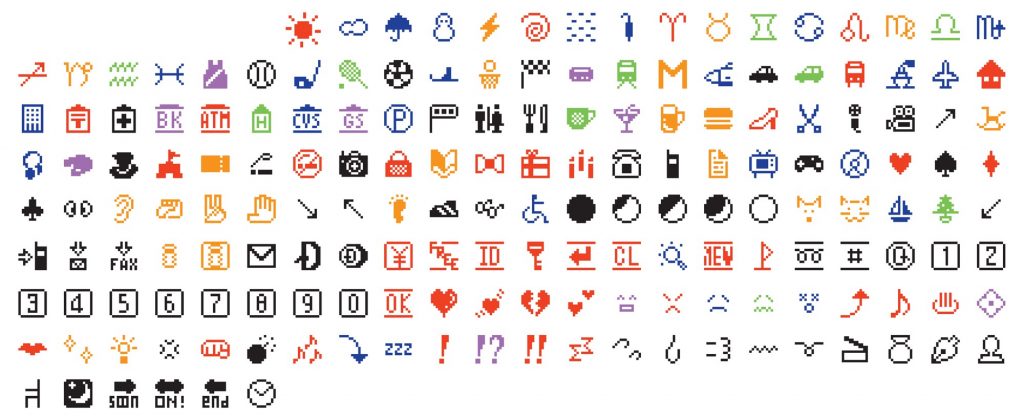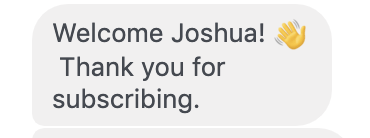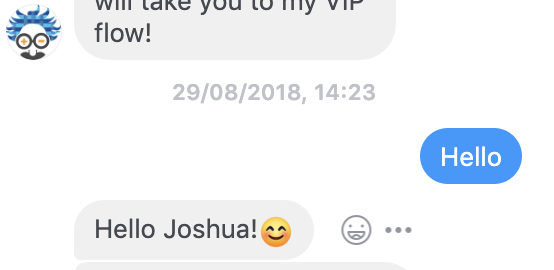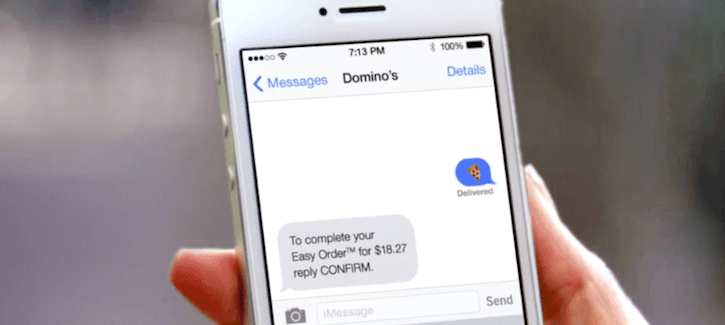What percentage of online consumers do you think use emojis? 🤔
50? 60? 70?
The answer is an amazing 92%! (Source)
Emojis haven’t just infiltrated messaging apps and communication channels, they’ve become part of our language.
And when something becomes a huge part of our daily lives, it gives marketers and businesses an opportunity to harness it and break down barriers.
If you would’ve asked business owners (and their marketing teams) whether they’re using emojis in their marketing communications just a few years ago, almost all of them would’ve 😂laughed😂 in your face.
The same can’t be said today, let’s examine why…
Contents
The History of Emojis 👨🎓
The first ever emoji was created in 1999 by Japanese artist 🇯🇵 Shigetaka Kurita 👨🏽🎨, who was working with a development team on an early mobile internet platform for Japan’s biggest mobile network carrier. [click_to_tweet tweet=”The word emoji comes from the Japanese for picture (‘e’) + character (‘moji’). Contrary to popular belief, it has nothing to do with the English word ‘emotion’.” quote=”The word emoji comes from the Japanese for picture (‘e’) + character (‘moji’). Contrary to popular belief, it has nothing to do with the English word ‘emotion’.” theme=”style3″]
Shigetaka’s original 176 emojis were just 12×12 pixels big and are now a part of the permanent collection at New York’s Museum of Art.
The originals don’t feature any yellow face’s 😲😤😭, which have arguably become the most recognisable designs of today’s emojis. Instead, they’re made up of icons that convey less emotional messages and carry much more direct meanings.
Here are Shigetaka’s first ever emojis:

To many, the idea of the emoji might sound like a really original idea, but to anybody who was around before the days of instant messaging (like me), you might remember using combinations of punctuation to express emotions via text and email:
‘;-)’ ‘:-|’ ‘:-\’
BTW: Did you know that there are currently 3,178 emojis in the Unicode Standard 🤓, and that number is sure to rise in future 🔝.
Emojis, the Universal Language (and an Emoji Game) 🌎 🌍 🌏
Emojis are used worldwide 🌍 and are instantly understood, making them the world’s first (and only) universal language.
Whilst they can only be used to share very basic messages, when strung together, emojis take on a language of their own.
BTW: The entire Moby Dick 🐳 novel has been translated into emoji language, with strings of emojis replacing the text. This version has been aptly named ‘Emoji Dick’. [click_to_tweet tweet=”The universal appeal and understanding of emojis make emotions, icons and relatable phrases easy game for brands who have previously struggled to feel close or relatable.” quote=”The universal appeal and understanding of emojis make emotions, icons and relatable phrases easy game for brands who have previously struggled to feel close or relatable.” theme=”style3″]
And just in case you don’t agree that emojis are able to share simple messages, we’ve translated 10 super-famous movie titles into emoji language. See how many you can get…
The Emoji Movie Game: Can You Guess The Movie Titles From These Emojis?
https://www.instagram.com/p/B7QbxyKpfQj/?utm_source=ig_web_copy_link
Check out our Insta (or click on the post above) to let us know how you got on (and find any answers that you haven’t figured out yet).
Oh, and if you are one of the few people who struggle to understand the meaning of emojis, Duolingo, one of the world’s biggest language educators, have created a free, no-obligation emoji language course.
Emojis, Communication and Marketing 👨💻📡💰
The question of whether you should use emojis in your brand’s communication and marketing messages no longer exists…
…the only question now is where 🕵️♀️ and how 👨🔬 you should use them.
I have seen reports and read guides from marketers who argue that emojis shouldn’t be used by ‘serious’ B2B companies. To me, this sounds like bad advice.

Yes, emojis aren’t serious or professional looking, but they can turn a brand that is perceived as boring, into something that’s fun, relatable and alive 😃.
BTW: In 2015, the Oxford Dictionary named the 😂Tears of Joy 😂emoji as the word of the year!
Of course, it goes without saying that emojis shouldn’t be used in communications where professionalism is required (e.g. an invoice, receipt or complaint handling).
But there are many other channels and opportunities for brands to speak in the same emoji-based language that 🚀92% 🚀of their target market use all the time.
Let’s examine the best places for brands to use emojis in marketing and communications…
Live Messenger/Chat 📲
The most common place that emojis are used in our day-to-day lives are in instant messaging apps 📲and programs. Think WhatsApp, Messenger, Instagram Direct (AKA Threads)…
…people use them to quickly reply to their connections, emphasise a message or convey an emotion ❤️.
As businesses online, we must aim to speak in our target market’s language 📢, but to increase the strength and relatability of this tactic, we must speak in their language in the place that they use it 🗺.
It’s no secret that chatbots and instant messaging between brands and customers has really 🛫 taken off 🛫in the last 2-3 years. Almost every business who sells, serves or has a presence online has a chatbot system on their Facebook page, as well as on their website 💻.

Chatbots allow businesses to quickly answer questions, save customers/prospects time and learn more about their market’s needs…and they’re a great place to use emojis.
Emojis can make AI (your automated chatbot) feel human, fun and charismatic. This makes them a must-have for your chatbot flows and automated responses.
You can use emojis to 💥emphasise points💥 and make your conversation feel more real, e.g.:

Or to map out directions when prospects have clickable responses to navigational questions:

Emojis can also be used by your customers to trigger an auto-response from your chatbot. A good example of this are Dominos Pizza. They set-up an automated system that allows users to order pre-programmed (saved) menu options for delivery, when they send the pizza emoji to their chatbot:

BTW: If you’d like to learn more about chatbots and how to use Instant Messaging for marketing, check out our case-study!
Social Media Ads 📈
Emojis disrupt attention and catch the eye 👁, making them a brilliant (and highly valuable) addition to social media ads.
In 2019 we spent more than £3 million on Facebook ads (alone), and have extensively tested 🔬the effect of emoji’s in ad copy. And we can conclusively confirm that in the majority of cases, emojis improve the performance of ads (in relation to their campaign objective).

Emojis act as another eye-catching, and relatable way to draw your target audience’s eye in a newsfeed that is packed with competition.
As a business, you should be able to find 🔎at least one emoji that directly relates to your product or services, and I’d recommend using this as often as possible 📌.
People instantly recognise and understand emojis, and by labelling your ad with an industry appropriate emoji, you give your target audience the ability to immediately qualify your content 😻.

In addition to your super-specific industry emoji, there are a few others that are sure-fire winners 🏆 over a multitude of niches. These are my favourite 5 emojis for ads on social media:
- ⏰⏰⏰( Red alarm clock emoji): This emphasises urgency and heightens the need for immediate action. It’s a great addition to any ad that has a limited time offer, and is aiming for more clicks.
- 🔥🔥🔥(Fire emoji): A real eye catcher, and one of the coolest and most popular emojis on the keyboard. The fire emoji highlights something that is taking off or igniting (literally catching fire), and is immediately recognised as this by 99% of audiences.
- 🛑🛑🛑(Red stop sign emoji): This emoji is the same as the universally understood symbol for stop, which is exactly what we want our audiences to do on our ads, and this is why it works so well.
- 😎😎😎(Black Sunglasses emoji): Another cool emoji, as well as being an eye catcher, this icon creates a sense of achievement. If you’re sharing valuable knowledge, this can be the perfect compliment.
- 😲😲😲(Astonished Face emoji): People are naturally curious and always want to close information loops when brands open them online. The stunned face creates a sense of intrigue as most people want to know what all the fuss is about. If you’re telling a story, running a big discount or have any other big news, try this emoji to capture attention.
Email 📩
Whilst I wouldn’t recommend using emojis in every email that you send, I would insist that you use them fairly regularly in a few different places.
The first 🥇and most obvious place to use emojis in emails is in the subject line.

A subject line that is backed up with emojis can clearly stand out in today’s inboxes 📬 (which are often filled with marketing materials), and can help increase your open rate.
Given the small space available for subject lines (particularly on mobile devices) it’s important that you don’t go overboard with emojis.
I’d recommend using one (or two max) in the opening of your message 💌. This allows you to use a written subject (to give your email a clear headline) and not look too spammy 🗑 (or desperate).
As well as the subject line, you can also use emojis in your email body text. As mentioned earlier, you probably shouldn’t use them in professional emails (e.g. invoices or receipts) but they can work wonders in email broadcasts 📻.
Many people will skim read through your email content, but by including emojis you give yourself the chance to draw them back into the text and re-engage with your message.

Try to use the most popular emojis to make your email content feel more like a conversation, or message from a friend/family member.
The world’s top 3 most used emojis in 2019 were:
- Tears of joy 😂😂😂
- Love heart ❤️❤️❤️
- Love heart eyes emoji 😍😍😍
(Source)
Blog/Written Content ✍🏼
After all my years of blogging, all the articles I’ve created, all the topics I’ve covered, all the websites I’ve written for, this is the first ever time that I’ve used emojis in a blog 😲.
There have been a few times in the past that I’ve flirted with the idea, but in the end, I’ve always decided against it ⚖️. That’s not to say that they don’t work, or you shouldn’t use them. There’s a very clear strategic decision behind why I don’t include emojis in my articles (at the minute)…
…and that’s because I want every single one of our blogs (and articles) to be instantly recognisable 🤩. Every time a regular reader sees one of our webpages, I want them to know what to expect, understand where they are and feel comfortable 🥰.

If I was to use emojis in blogs, I’d have to keep up with this tactic to keep our style and format recognisable. Hopefully, anybody who has ever visited an Einstein Marketer article, would instantly know that they’re on one again (just by looking at the page style and content format).
I know of a lot of awesome blogs that use emojis in every post, and they work (for all the other reasons highlighted in this complete guide to emojis). Either stick with them 💯 or don’t use them at all.
BTW: This article is an exception to my no-emoji rule.
Social Media 💪🏽🚀🏄🏻♀️
As well as using emojis in your social media ads, you should also be using them in your day-to-day 📆social media posting, commenting and social listening.
Emojis can be used in the same tactical way that they’re added to social media ads, but this isn’t the only way that you should use them on social.
For starters, emojis give brands a really quick way of sharing freshly posted content on social, and adding their opinion to it. Content like this is a social media manager’s dream 🌈because it doesn’t take any time to create or plan, and by sharing other people’s content, you’re much more likely to receive shares in return.

As well as this, you can quickly comment on your target market’s content with emojis on social 👨👨👦👦 (or add them to comments to provide more value), or comment on the content of rivals (or big industry players) to grab and steal the attention of their followers.
These are both awesome emoji marketing tactics for social media, but my personal favourite (and what I consider the most effective) is to socially listen 👂to your target market’s use of emoji language.
Everything that has been included in this marketing guide to emojis means nothing if you don’t understand who your target market is 🎯and how they speak to each other. [click_to_tweet tweet=”On social media you effectively have a looking glass that peers directly into your target market’s use of language.” quote=”On social media you effectively have a looking glass that peers directly into your target market’s use of language.” theme=”style3″]
Go to some of your follower’s personal profiles on social and look through their posts until you find comments and messages, analyse what type of emoji’s they’re using. Do this for as many of your followers as you have time to analyse, and then examine your results 🔬.
When you know the type of emojis (and language) that your audience are using, you should use them for all the other tactics and strategies in this guide! You’ll be much more relatable, especially if you discover something that others aren’t using 🧲.
Feedback 🤗😐🤬
Despite having awesome experiences, most customers are too busy or simply cannot be bothered 😴 to leave a review about your business, brand or website (I know I’ve been guilty of this in the past!).

However, a number of different software companies have released plugins and apps that allow users to simply click 🖱 on the emoji that best represents their experience.
These feedback buttons can be as simple as a rating of happy 😁 to sad 😟, or they can be more complex by offering users a range of different emotions to describe their experience.

By collecting feedback you can understand what needs improving, what your customers love ❤️and where you can make improvements.
Simply by asking your existing audience, leads or customers to click on the most representative emoji, you stand to capture 🎣much more information about your product, service and user experience, and as I’m sure you know, this is the best way to optimise it.
Clicking on an emoji is fast and requires very little thought, effort or time (especially in comparison to writing a review), which makes it a highly responsive form of collecting feedback/reviews.
Emojis in Marketing: Conclusion 🔚
Emojis offer brands an incredible opportunity to be relatable, fun and closer to their target market.
It’s important that you try to speak in your target market’s language 🗣, on their platforms. By using emojis tactically, you can be much more than just another business online 💁🏾♂️.
Be careful not to overuse them or turn your prospects away from your brand by using them in situations where more serious communication forms are required.
And finally, let me know what you think of this article by leaving an emoji in the comments, on our social posts or sending one directly to me (or us)!
Did you enjoy this emoji guide to marketing? Check out one of our other most popular articles:
- The Psychology of Colour in Marketing
- Facebook Page Likes: How to Get 1,000’s for Free
- Priming in Marketing: Advertising Psychology 101
- Author Details





8 Responses
This is really important for search engine ranking, however, the writer is a very well said on this topic.
😎
Great article! I try to use emojis as often as possible because it’s the way my market speak to each other. Thanks for this guide Josh.
bookmarked!!, I like your website!
This is a wonderful summary of how to use emojis and why they are important for B2B marketing.
Thank you Kalee! We’re glad you find it useful!
Your blog posts are remarkable .. ….
Thank you !!! We’re glad you find it useful!